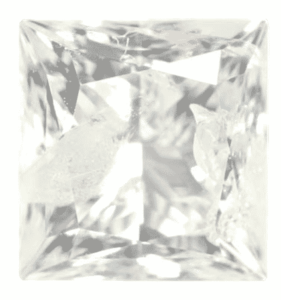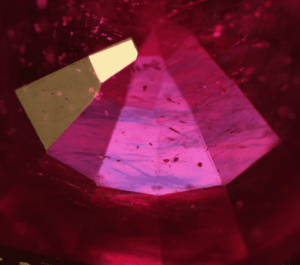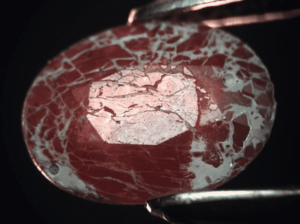Filling is a gemstone enhancement method that indicates a broad range of treatments. From simple oiling to resin impregnation to the filling of fractures with glass or synthetic gem material with the aid of fluxes.
Oiling
Oiling has been around since antiquity and is still one of the most commonly encountered gemstone treatments. It incorporates the filling of surface reaching fractures in both rough and cut stones with the aid of an oil. Applying oil, with a refractive index near that of the stone it’s being applied to, hides the cracks in the gemstone and gives the stone the appearance of more color. Care should be taken when handling such treated gemstones as the oil can easily be removed by detergents or an organic solvent such as benzene. This treatment is not stable; the oil will dry out over time.
Impregnation
Resin impregnation is a relatively new technique that probably saw the light of day in the 1990s. Instead of oil epoxy resin is used to fill the cracks. Resins are not just used to fill surface-reaching fractures but also to stabilize and color porous materials such as opals, jade and turquoise.
Glass Filling
Diamonds

According to their own website, Yehuda has been glass-filling diamonds since 1982. The first reports of this treatment came in 1987 though when Koivula published an article on it in the G&G. The characteristic ‘flash-effect’ gives this treatment away, note the iridescent colors in the top right corner of this filled diamond. Flow structures indicate the presence of glass as well.
Rubies


Surface-reaching cracks in rubies have been filled with lead glass since at least 1984. In this year the first filled stones were submitted to labs. This was colorless glass that had been used to fill surface cavities. The presence of gas bubbles in the glass filler proved an easy method to spot these fillings together with the difference in lustre of the filled areas versus the rest of the stone.
These days we see a lot of lead glass-filled rubies that are produced from Mozambican low-quality starting material. The filled areas can be spotted by the ‘blue flash’, the occasional bubble and lustre difference. The glass used is susceptible to chemical wear when brought in contact with acids. Even lemon juice and vinegar will damage the glass after relatively short contact periods as you can clearly see in the image below.

Flux Filling
In 1992 a new filling method presented gemologists with another challenge: the flux healing of sapphires. The new ruby find in Myanmar at Mong Hsu produced a lot of fractured crystals. Thai burners enhanced the unattractive appearance of these stones by first cleaning them with acids and then heating them in a flux with or without AlO2. This causes a ‘synthetic’ intergrowth of corundum to occur in the cracks which seals them. A very nifty treatment that aids the gemstone a lot, both in appearance and in durability. There are no known issues with this treatment in terms of durability.
They may serve as a good clue to the appraiser though. The flux healing almost always leaves flux feathers in the used-to-be cracks. The course nature and opaqueness of these flux remnants act as a readily identifiable feature that dates rubies to post-1992.
Filling
| Gem Material | Result | Date of Introduction |
|---|---|---|
| Beryl (Emerald) | Clarity/Color Enhancement by (Colored) Oil or Epoxy Resin | Oil – BCEpoxy Resin – 1994 ( Levy, 1994 ICA Gazette, April) |
| Clarity/Color Enhancement | ||
| Oiling | BC | |
| Glass Filling | BC | |
| Corundum | Flux Healing | Glass Filling of Surface Reaching Cavities in Rubies 1984 (http://www.ruby-sapphire.com/foreign-affairs.htm Hughes, 1992] Flux Healing of Surface Reaching Cavities in Rubies 1992 (http://www.ruby-sapphire.com/foreign-affairs.htm Hughes, 1992) |
| Diamond | Glass Filling | 1982, Zvi Yehuda |
| Color/Stability Enhancement: | ||
| Jade | Impregnation | ? |
| B-Jade | ? | |
| C-Jade | ? | |
| Opal | Impregnation: Stability Enhancement | ? |
| Turquoise | Impregnation: Color and Stability Enhancement | ? |